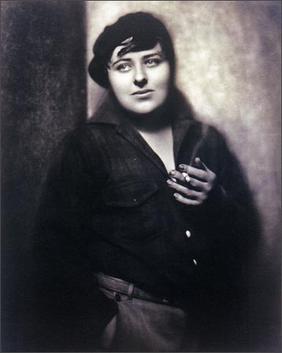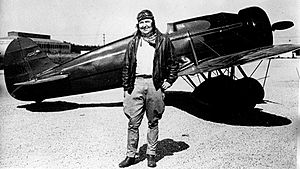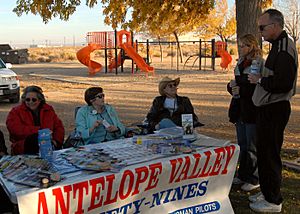Pancho Barnes facts for kids
Florence Lowe "Pancho" Barnes (born July 22, 1901 – died March 30, 1975) was a brave and skilled American pilot. She was a pioneer in aviation and helped create the first union for movie stunt pilots. In 1930, she flew faster than Amelia Earhart's air speed record.
Pancho Barnes also took part in the Women's Air Derby, a famous air race. She was a member of the Ninety-Nines, a group for women pilots. Later in her life, she became well-known for owning the Happy Bottom Riding Club. This was a popular restaurant and bar in the Mojave Desert in Southern California. It was a favorite spot for famous test pilots and aviators who worked nearby.
Contents
Pancho Barnes' Early Life
Florence Leontine Lowe was born on July 22, 1901, in Pasadena, California. Her parents were Thaddeus Lowe II and Florence May Dobbins. She came from a rich family and grew up in a large house in San Marino, California. She went to the best private schools in the area.
Her father loved outdoor activities and encouraged Florence to enjoy nature. She became a very good horseback rider. Her grandfather was Thaddeus S. C. Lowe, who was important in early American aviation. He started the first military air unit, the Army of the Potomac's balloon corps, during the American Civil War. When Florence was 10 years old, her grandfather took her to an air show, which sparked her interest in flying.
In 1919, Florence married Reverend C. Rankin Barnes. They had a son named William E. Barnes. Her mother passed away in 1924.
Pancho Barnes' Aviation Career
After traveling for a few months, Florence started using the nickname "Pancho." In 1928, she decided to learn to fly. She convinced Ben Catlin, a World War I pilot, to teach her. She flew her first solo flight after only six hours of lessons.
Pancho Barnes quickly became known for her flying skills. She performed in air shows, where pilots did daring stunts. She also competed in air races. In 1929, she crashed during the Women's Air Derby, but she didn't give up. In 1930, she returned to the race with the help of the Union Oil Company. She won the race and broke Amelia Earhart's world speed record for women. Pancho flew at 196.19 miles per hour (315.74 km/h) in her special Travel Air Type R Mystery Ship.
After her racing contract ended, Pancho moved to Hollywood. She started working as a stunt pilot for movies. In 1931, she created the Associated Motion Picture Pilots. This was a union for stunt fliers in the film industry. It helped make flying safer and set fair pay for stunt work. She flew in several adventure movies in the 1930s, including Howard Hughes' Hell's Angels (1930).
Pancho Barnes knew many people in Hollywood. She helped her friend George Hurrell, a photographer, start his career. She introduced him to her Hollywood friends, and he became a very famous photographer.
During the Great Depression, Pancho lost most of her money. In 1935, she sold her last property in Hollywood. She then bought 180 acres (73 ha) of land in the Mojave Desert. This land was close to the Rogers dry lake bed, which later became Muroc Field.
The Happy Bottom Riding Club
On her land, Pancho Barnes built the Happy Bottom Riding Club. It was also called the Rancho Oro Verde Fly-Inn Dude Ranch. This place was a restaurant and a guest ranch. It became a popular spot for airmen from the nearby airfield and Pancho's Hollywood friends.
Pancho became very good friends with many early test pilots. These included famous names like Chuck Yeager, Robert Anderson "Bob" Hoover, and General Jimmy Doolittle. Her ranch became famous for its lively parties and fun times.
After successful test flights, pilots from Muroc and Edwards Air Force Base often visited the Happy Bottom Riding Club. Pancho would give them a free steak dinner if they broke the sound barrier.
In 1952, Pancho had a disagreement with the United States Air Force (USAF). The USAF wanted to build a new, very long runway. This runway was planned to cross directly over her ranch. The USAF offered her a low price for her land. Pancho asked for a fair price that matched the true value of her property and business.
During this time, her ranch burned down in a fire in 1953. The value of her property dropped even more. Pancho decided to sue the USAF. She wanted to get a fair price for her land and clear her name. She argued that her grandfather had played a key role in the early days of American aviation. The court agreed with her. She was awarded $375,000 for her property and business, and her name was cleared. Interestingly, the proposed runway was never built.
After the government bought her out, she moved to Cantil, California. She hoped to start a similar ranch business there, but it did not happen. In the late 1960s, Pancho became a regular visitor at the base again. People started calling her the "Mother of Edwards AFB." The officers' dining hall at Edwards was even renamed the Pancho Barnes Room.
Pancho Barnes' Death
Pancho Barnes had breast cancer, which likely caused her death. She was supposed to speak at an event on April 5, 1975. However, a friend could not reach her on March 30, 1975. Her son, Bill, found her at home. The coroner said she had died about a week earlier.
Bill received special permission from the United States Air Force. He was allowed to spread her ashes over the site of the Happy Bottom Riding Club. He flew a small plane over the area. A crosswind blew the ashes back into the plane. It was said that "Even in death Barnes still loved a good joy ride."
Pancho Barnes' Legacy
Pancho's fourth husband, Eugene "Mac" McKendry, lived in Cantil for many years after her death.
Her son, Bill Barnes, died in October 1980 while flying a North American Aviation P-51 Mustang near Fox Field in Lancaster. Pancho had started Barnes Aviation in Lancaster in 1940. Bill ran the business when he grew up, and it is still in operation today.
Pancho Barnes' life story was shown in the 1983 movie The Right Stuff. Kim Stanley played her in the film. She was also the subject of a 1988 TV movie called Pancho Barnes, starring Valerie Bertinelli. Several books have been written about her life, including The Lady Who Tamed Pegasus by Grover Ted Tate (1986), Pancho: The Biography of Florence Lowe Barnes by Barbara Schultz (1996), and The Happy Bottom Riding Club by Lauren Kessler (2000).
PBS also supported a documentary film about her, The Legend of Pancho Barnes and the Happy Bottom Riding Club, released in 2009. In this film, Kathy Bates provided the voice of Pancho Barnes. The documentary won an Emmy award.
Pancho Barnes' special racing plane, the Mystery Ship #32, was kept in a hangar at Mojave Airport for a long time. It was later sold to a collector and is now in the United Kingdom, where it has been restored.
The historic site of the Happy Bottom Riding Club is still used today. It hosts the annual USAF Test Pilot School/Edwards Air Force Base Pancho Barnes Day celebration. This event started in 1980. It includes a barbecue, drinks, dancing, and live music to remember this amazing aviation pioneer.
Pancho Barnes and the Happy Bottom Flying Club are featured in the comic series DC: The New Frontier, where a young Hal Jordan visits them.
In the 2019 movie Captain Marvel, the fighter pilot bar is called Pancho’s Bar. This is a tribute to Pancho Barnes and her famous nickname.





